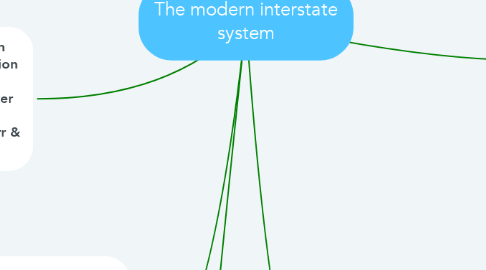The modern interstate system
by Kagiso Laudino

1. The concept of the modern interstate system- The concept 'international system' refers to the complex whole that covers the globe and is formed by all the units or actors comprising this system, plus the sum of all interactions among these component units or actors. These units or actors can be nation-states (For instance South Africa, Kenya and Malawi), inter-governmental organizations, or IGOs, such as the United Nations, the African Union and Southern African Development Community (McGowan, P, Cornelissen S & Nel, P,2018,p.100)
2. The origins and principles of the modern inter-state system - The origins of the modern state system go back some 700-800 years to the end of the feudal era in Europe, and started with the consolidation of the Capetian dynasty between the 10th and 13th centuries (Spruyt, 1994:77-108). These origins were tied up closely with: ●Expanded trade in Europe during that period and the consequent growth of towns and cities as centers of exchange. ●The resultant need, on the one hand, for standardised measures for weight, volume and value and, on the other, the need for a secure legal order to reduce transaction and information costs ●The growing demand for effective security that could be provided only by larger, more centralized military powers. -As the personalised and localised form of rule in feudal Europe began to disintegrate, three different contenders emerged as possible political successors -The first was the loose confederation of Hanseatic trading states (the Hansa League) in Northern Europe, -The second was the Italian city-states, such as Venice, Genoa, Pisa and Florence, which successfully resisted monarchic inclusion and maintained a large degree of local sovereignty until about 1450 (McGowan, P, Cornelissen, S & Nel, P, 2018, p.101 & 102)
3. Configurations of the modern inter-state system. - Polarisation refers to a situation in which members of an alliance 'cluster around the system's most powerful states'(Russett, Starr & Kinsella,2000:79)
4. Configurations of the modern inter-state system - The modern inter-state system contains specific configurations, or organising patterns, which are bipolar, unipolar, multi-polar and uni-multipolar systems (Rosecrance, 1966:314-327; Holsti, 1995). -What distinguishes systems from one another are their respective structural configurations
5. A bipolar system is a system in which two states or group of states have a preponderance of power over the actors. This bipolar system was characterized by the pursuit of opposing ideologies by two opposing and powerful states (also called hegemons)


